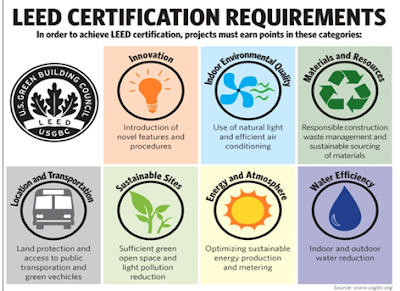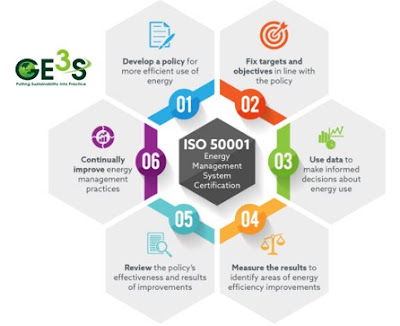LEED Rating System
Leadership in Energy and
Environmental Design (LEED) is the most widely used Green building rating system in the world. LEED certification for a
building symbolizes how sustainable the building is throughout its life cycle
in terms of resource use, energy efficiency and conservation, water efficiency
and choice of building materials.
LEED rating system focuses on eight
credit categories namely (i) Location & Transport, (ii) Sustainable Sites,
(iii) Water Efficiency, (iv) Energy & Atmosphere, (v) Materials &
Resources, (vi) Indoor Environmental Quality, (vii) Innovation and (viii)
Regional Priority. Each of these credit categories consists of prerequisites
and credit points required to achieve LEED rating. The LEED rating for a
building can be achieved in four levels namely
1. Certified: 40-49 credit points; 2.
Silver: 50-59 credit points; 3. Gold: 60-79 credit points;
4. Platinum: 80+ credit points.
Benefits of LEED Rating System
Sustainable buildings are the need of the hour in current
situation in a world influenced by increased water and energy use, depletion
and exhaustion of valuable resources. Studies shows that buildings account for
40% of the global energy use, 19% of energy related greenhouse gas emissions,
and approximately one-third of the carbon emissions. Design and development of
sustainable buildings not only reduces the use of resources but also paves way
for a positive impact on the environment. Some of the benefits of a LEED
certified buildings are as follows:
LEED certification are universally
recognized and creates a good example to clients, neighbours and family on the
positive impacts of a sustainable building;
LEED certified buildings consumes
relatively less amount of energy and water throughout its life cycle thereby
reducing the environmental footprint;
One of the key aspects of LEED building certification is its
emphasis on indoor air quality. Studies shows that Indoor air in most buildings
which are not LEED certified are polluted. LEED certified buildings eliminate
the pollution levels in the indoor air through effective HVAC designs;
LEED certified buildings relatively
uses less hazardous building materials for their construction and also
emphasize on the use of materials with less volatile content. It also prohibits
the use of certain hazardous materials to be used in the building construction;
LEED certified buildings promotes
the use of sustainable transportation and tries to reduce transportation
through privately owned automobiles by providing accessibility to facilities
and amenities nearby the building. It also emphasize on the use of green
vehicles and use of public transport system which in turn reduces the
environmental footprint.
GE3S has a dedicated team of LEED
qualified professionals with broad experience on multiple projects spanning
across several countries. GE3S’s experienced staffs are well versed in the
practical and cost effective application of LEED in the unique climate and
context of the various part of world. Team’s experience and the lessons learned
from the process is extremely valuable when assisting project teams in
achieving the desired LEED rating in the most effective manner.





Comments
Post a Comment